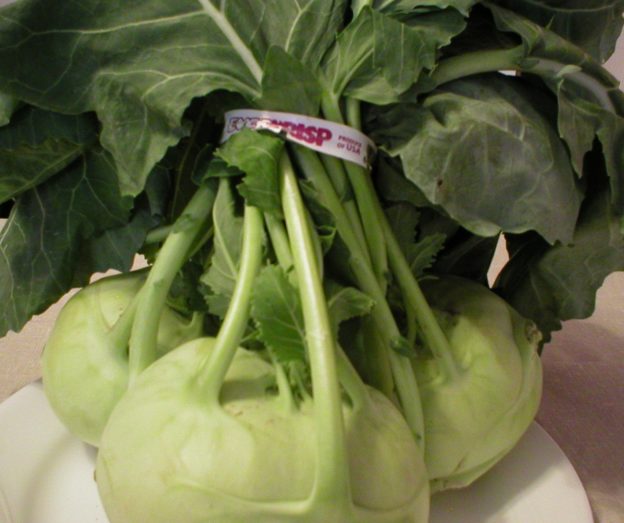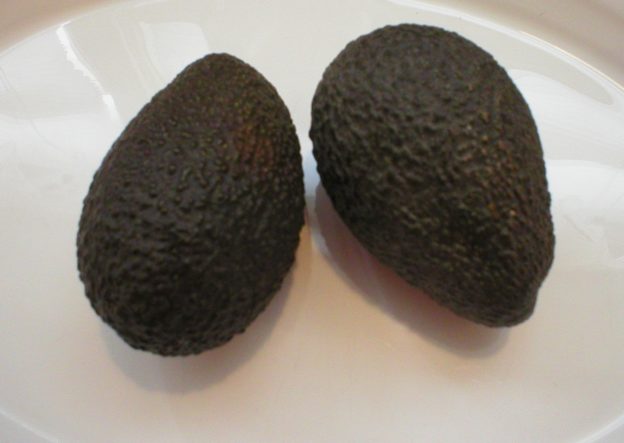Kohlrabi 101 – The Basics (UPDATE)
About Kohlrabi
Kohlrabi is also known as a German cabbage-turnip. It is a member of the cruciferous vegetable family, so it is related to cabbage, cauliflower, broccoli, Brussels sprouts, mustard, and more. Kohlrabi is very popular in Northern and Eastern European countries, such as Germany, Hungary, northern Vietnam, and eastern India.
The kohlrabi plant forms a round bulb above ground with long, leafy stems growing upward from the top and sides of the bulb. The bulb can be white, pale green, or purple in color. Despite the color of the peel, the flesh is always white-yellow inside. The bulb, stems, and leaves are all edible. The texture of the kohlrabi bulb is crispy without being tough. The flavor is similar to broccoli and cabbage, often with a slight radish taste. Smaller kohlrabi may be more tender and slightly sweeter than larger ones. The flavor of the stems and leaves is similar to kale; however, they are not as tough and rubbery as kale.
Nutrition and Health Benefits
Like other vegetables in the cruciferous family, kohlrabi has excellent nutritional value. It is high in Vitamin C, fiber, Vitamin B6, potassium, magnesium, manganese, folate, Vitamin B1, protein and Vitamin E. One cup of raw kohlrabi provides almost all of your daily needs of Vitamin C (93%) with only 36 calories.
Antioxidant Protection. Vitamin C is the body’s most important antioxidant. With kohlrabi being so high in Vitamin C, it can play an important role in protecting the body from free radical damage, promoting wound healing, collagen synthesis, iron absorption, and supporting immunity.
Kohlrabi also contains other important antioxidants such as anthocyanins, isothiocyanates, and glucosinolates that work together with Vitamin C in helping to protect the body from oxidative damage that can lead to cancer and other serious diseases.
Digestive Support. With kohlrabi being high in both soluble and insoluble fiber, including it in the diet helps to support gastrointestinal health. Fiber helps to keep the digestive tract contents moving forward along with promoting the development of colonies of healthful bacteria in the colon. This supports the immune system, and reduces our risk of bowel diseases including cancer.
Cardiovascular Health. With kohlrabi being very high in both soluble and insoluble fiber, it helps to reduce the risk of heart disease. Soluble fiber is known to bind with bile in the digestive tract, removing it in the feces. This forces the liver to make more bile using existing cholesterol in the process. This, in turn, helps to keep blood cholesterol in check. A review of 15 research studies found that a diet rich in fiber decreased the risk of death from heart disease by 24% when compared with subjects eating a low-fiber diet.
Kohlrabi is also a good source of potassium, an electrolyte known for its important role in fluid balance, supporting heart health.
Furthermore, kohlrabi is rich in glucosinolates and isothiocyanates, found mostly in cruciferous vegetables. A high intake of these compounds has been shown to lower the risk of heart disease by relaxing blood vessels, lowering blood pressure, and reducing inflammation. Their antioxidant properties may also prevent plaque buildup in the arteries.
Supports Immunity. Kohlrabi is high in Vitamin B6, which is known for supporting many functions including protein metabolism, red blood cell development, and immunity. The vitamin is used in the production of white blood cells and T-cells that fight foreign substances and are critical in a healthy immune system. Deficiency of Vitamin B6 has been linked to a weakened immune system.
Also, the high amount of Vitamin C found in kohlrabi also supports the immune system by functioning as an important antioxidant and supporting white blood cell function.
Low Glycemic Index. Kohlrabi has a low glycemic index, which reduces the spike in blood sugar following a meal. Eating foods with a low glycemic index can help improve satiety and manage blood sugar in everyone, including people with diabetes. Also, improved satiety can aid with weight loss and help to improve overall metabolism.
How to Select Kohlrabi
Choose kohlrabies that have a firm, smooth skin without cracks. Depending on the variety, the color can be white, light green, or purple. If the leaves are attached, they should be firm and green. Avoid those with yellow and/or wilted leaves.
The smaller kohlrabies taste more like broccoli, whereas larger ones are more radish-like and can be woody. For a more tender texture and sweeter flavor, choose smaller ones, about 3 to 4 inches in diameter.
How to Store Kohlrabi
Store your unwashed kohlrabi in the refrigerator. Remove the stems from the bulb and store them wrapped loosely in a plastic bag. The leaves will not keep very long, so plan to use them within several days.
Store the bulbs in the crisper drawer of the refrigerator with the air vent closed. This will help to maintain a humid environment for the vegetable. Use the bulb within two weeks, although it may keep longer than that.
How to Prepare Kohlrabi
If you have not already removed the stems from the bulbs, you will need to do that first. Then wash everything well in cool water. The stems and leaves may be used like spinach or kale. The peel of kohlrabies gets tough as they get larger. So, larger ones will need to be peeled first with a vegetable peeler or sharp paring knife. Smaller, more tender kohlrabies may not need to be peeled.
Kohlrabies can be cut in many ways: shredded, julienned, diced, sliced, or cubed. They can even be scooped out and stuffed, if desired. They may be eaten raw or cooked.
How to Freeze Kohlrabi Bulbs
Kohlrabi bulbs may be frozen. First remove stems and wash them well. Peel them (if the peel is tough), then leave them whole or cut them into cubes, as preferred. Bring a pot of water to boil, then place the prepared kohlrabi in the water. Immediately set the timer: 3 minutes for whole bulbs, 1 minute for cubes. As soon as the timer is finished, immediately transfer the kohlrabi to a bowl of cold water and allow them to cool down for as long as they were in the boiling water. Drain well and transfer them to an airtight container or freezer bag, and label it with the current date. For best quality, use them within one year.
Quick Ideas and Tips for Using Kohlrabi
* Kohlrabi may be enjoyed raw, steamed, fried, glazed, boiled, baked, stuffed, grilled or roasted. How you use kohlrabi is limited only to your imagination!
* Try sautéed kohlrabi leaves with a little garlic. Top with a drizzle of lemon juice and a sprinkling of grated Parmesan cheese. Enjoy!
* Be sure to remove the tough outer skin before eating the kohlrabi bulb.
* The leaves of kohlrabi are edible and tasty. Prepare them like you would kale or spinach.
* Kohlrabi can be added to soups, stews, and curries.
* Add kohlrabi to your favorite stir-fry with other vegetables. Serve over rice for an easy meal.
* Kohlrabi can be cooked then added in with mashed potatoes.
* Add shredded raw kohlrabi to your favorite coleslaw.
* Try adding thinly sliced or shaved kohlrabi to sandwiches and wraps.
* When roasting kohlrabi, cook it until it is fork-tender. When sautéing or steaming kohlrabi, cook it only until it is just crisp-tender.
* Try adding some kohlrabi to creamy potato or broccoli soup.
* If a recipe calls for rutabaga and you don’t have any, you can use kohlrabi instead.
* Enjoy slices of raw kohlrabi with your favorite hummus or dip.
* Try stuffed kohlrabi. Peel the bulb, then hollow out the core and stuff it with whatever mixture of vegetables, grains, and proteins you prefer. Then bake until it is fork tender. Enjoy!
* Four medium kohlrabi bulbs weigh about 2 pounds. That yields about 3-1/2 cups cubed and cooked.
* If a recipe calls for kohlrabi greens and you don’t have any, you can substitute them with turnip greens, collard greens, mature spinach, bok choy, mustard greens, or kale.
Herbs and Spices That Go Well with Kohlrabi
Anise, basil, caraway seeds, cayenne, chervil, cumin, curry powder, curry spices, dill, marjoram, mint, mustard powder, mustard seeds, nutmeg, paprika, parsley, rosemary, salt, tarragon, thyme (and lemon thyme), turmeric
Foods That Go Well with Kohlrabi
Proteins, Legumes, Nuts, Seeds: Almonds, bacon, beans (in general), bean sprouts, beef, chicken, ham, lentils, peas, seafood, sesame seeds
Vegetables: Broccoli, cabbage, carrots, celery, celery root, chiles, chives, cucumbers, fennel, garlic, ginger, greens (in general), horseradish, leeks, lettuce (in general), mushrooms, onions, potatoes, radishes, root vegetables (in general), shallots, spinach, tomatoes, turnips
Fruits: Apples, blueberries, cantaloupe, honeydew melon, lemon
Grains and Grain Products: Corn, couscous, quinoa, rice
Dairy and Non-Dairy: Butter, cheese (in general, esp. Blue, feta, goat, Gouda, Parmesan, ricotta, Swiss cheese), cream, sour cream
Other Foods: Maple syrup, mayonnaise, mustard (prepared, i.e., Dijon), oil (esp. grapeseed, mustard, olive, peanut, sesame), soy sauce, stock, sugar (esp. brown), vinegar (esp. balsamic, fruit, red wine, rice wine, white wine)
Kohlrabies have been used in the following cuisines and dishes…
Casseroles, Southern Chinese cuisine, crudités, Northern European cuisines, German cuisine, gratins, Hungarian cuisine, Indian cuisine, purees, rémoulades, risottos, salad dressings, salads (i.e., grain, green, vegetable), sauces, slaws, soups, spring rolls, stews, stir-fries
Suggested Food and Flavor Combos Using Kohlrabi
Add kohlrabi to any of the following combinations…
Apples + Lemon + Mustard [in slaws]
Basil + Mushrooms
Celery Root + Nutmeg + Onions + Potatoes
Chili Pepper Flakes + Mustard
Chives + Lemon
Dill + Feta Cheese
Dill + Horseradish + Lemon Juice + Sour Cream
Garlic + Parmesan Cheese + Parsley [in risotto]
Garlic + Soy Sauce
Sesame Seeds + Soy Sauce
Recipe Links
Chicken, Kohlrabi, and Cashew Stir-Fry https://producemadesimple.ca/chicken-kohlrabi-cashew-stir-fry/
Carrot and Kohlrabi Slaw https://www.thespruceeats.com/carrot-kohlrabi-slaw-2217352
Hungarian Creamy Kohlrabi Soup https://www.thespruceeats.com/hungarian-creamy-kohlrabi-soup-1137419
Roasted Kohlrabi https://www.thespruceeats.com/roasted-kohlrabi-recipe-2216540
Kohlrabi and Cabbage Salad with Maple Lemon Dressing https://www.thekitchn.com/recipe-kohlrabi-and-cabbage-salad-with-maple-lemon-dressing-passover-recipes-from-the-kitchn-217338
5 Tasty Ways to Prepare Kohlrabi https://www.thekitchn.com/5-tasty-ways-to-prepare-kohlrabi-60321
10 Delicious Ideas for Cooking with Kohlrabi https://www.marthastewart.com/1033766/kohlrabi-recipes
Crisp Apple and Kohlrabi Salad https://cookieandkate.com/crispy-apple-kohlrabi-salad-recipe/
3 Kohlrabi Recipes to Help You Cook This Unusual Vegetable https://www.tasteofhome.com/article/3-kohlrabi-recipes-to-help-you-cook-this-unusual-vegetable/
Kohlrabi Slaw with Cilantro, Jalapeno, and Lime https://www.feastingathome.com/kohlrabi-salad-with-cilantro-and-lime/
12 Killer Kohlrabi Recipes https://www.brit.co/kohlrabi-recipes/
Kohlrabi Fries https://nutritiouslife.com/recipes/kohlrabi-fries/
Kohlrabi Schnitzel https://www.elephantasticvegan.com/kohlrabi-schnitzel/
Kohlrabi Gratin https://www.eatingwell.com/recipe/275789/kohlrabi-gratin/
Polish Kohlrabi Soup https://www.everydayhealthyrecipes.com/polish-kohlrabi-soup-zupa-z-kalarepy/
Kohlrabi Curry https://www.flavourstreat.com/kohlrabi-curry-knol-khol-curry/
Honey-Glazed Kohlrabi with Onions and Herbs https://www.myrecipes.com/recipe/honey-glazed-kohlrabi-onions
Resources
https://producemadesimple.ca/goes-well-kohlrabi/
https://producemadesimple.ca/kohlrabi/
https://lpi.oregonstate.edu/mic/food-beverages/cruciferous-vegetables
https://www.healthline.com/nutrition/kohlrabi#what-it-is
https://www.cheatsheet.com/health-fitness/healthiest-foods-youve-never-heard-of.html/
https://tools.myfooddata.com/nutrition-comparison/168425-168424/wt1-wt1/1-1
https://www.webmd.com/diet/health-benefits-kohlrabi#1
https://www.thespruceeats.com/all-about-kohlrabi-2216537
https://foodal.com/knowledge/paleo/kohlrabi-storing-using/
Joachim, David. (2010) The Food Substitutions Bible. 2nd Edition. Toronto, Ontario, Canada: Robert Rose, Inc.
Page, Karen. (2014) The Vegetarian Flavor Bible. New York, NY: Little, Brown and Company.
About Judi
Julia W. Klee (Judi) began her journey enjoying “all things food” in elementary school when she started preparing meals for her family. That love of food blossomed into a quest to learn more and more about health and wellness as related to nutrition. She went on to earn a BS Degree in Food and Nutrition, then an MS Degree in Nutrition. She has taught nutrition and related courses at the college level to pre-nursing and exercise science students. Her hunger to learn didn’t stop upon graduation from college. She continues to research on a regular basis about nutrition as it relates to health. Her hope is to help as many people as possible to enjoy foods that promote health and wellness.


